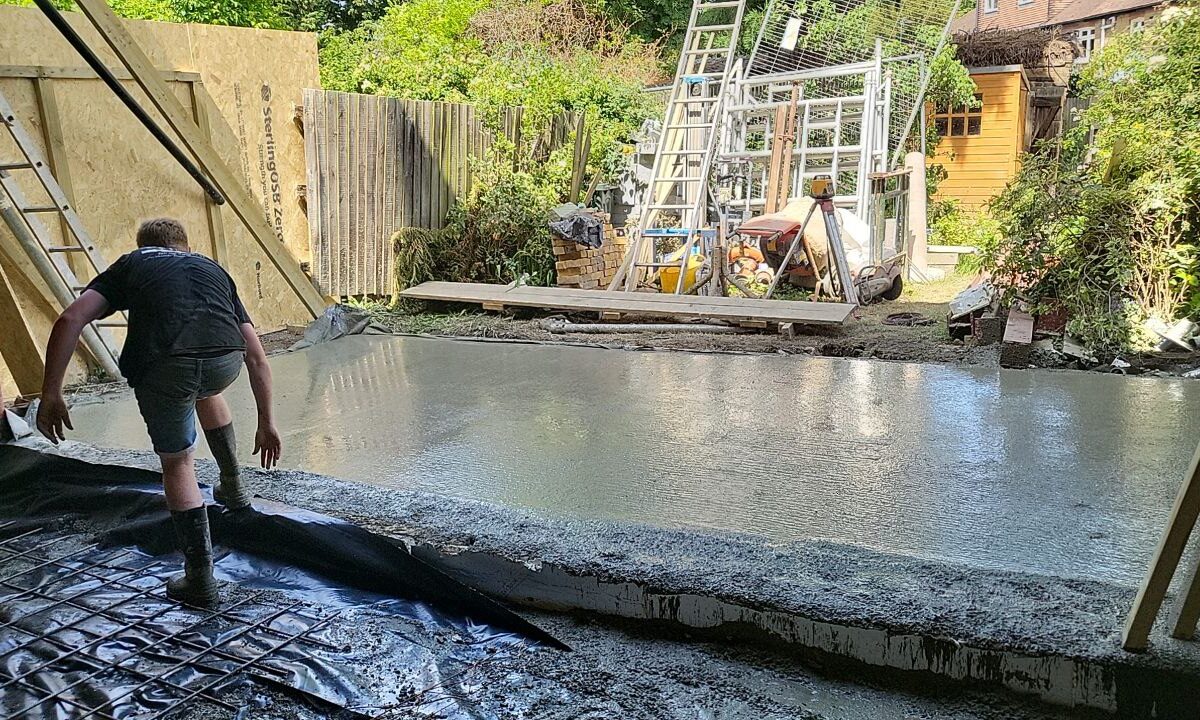First, we need to determine the type of foundation you need. We advise that you call a qualified professional for an inspection to help you understand the type of foundation you need to accommodate your extension.
5 main types of foundations that we use for house extensions.
1. Strip foundation
This is the most common foundation type, mainly used on modern extensions starting at 1000mm depth up to 1500mm. A piled foundation will then be required.
2. Raft foundation
These are reinforced concrete slabs that cover the entire area of the extension. Raft foundations help create a large surface area to spread the load and are convenient for weak ground or drainage.
3. Trench-Fill
This is the simplified version of a strip foundation. For this type of foundation, our team will generally dig a trench to an appropriate depth and pour concrete directly into it, which will then be reinforced.
4. Pad Foundation
This foundation supports isolated loads, such as those created with heavy steel beams or at joint intersections for post-and-beam frame houses.
5. Piled Foundation
Piled foundations are used when the building ground consists of high shrinkage clay. This type of soil is typically found in southern England.
Please keep in mind that certain trees close to the building area would also be one of the reasons why piling will be required.
Soil types
To ensure that piling for your house extension is needed, you will need to consider the soil types. Bear in mind that even if you’ve already decided that you will need pilings, the kind of soil will determine which type of pilings are required.
If you want to learn more about the soil type in your area, you can call your local building control department. They will probably have information or general knowledge of your area’s different soil types. They can also help you better understand the type of foundation you might need.
To help you understand what we mean by soil types, here are 6 types of soil you might come across.
Rock
Gravel
Sand
Clay
Peat
Chalk
Soils composed of sand, clay, or peat can be an issue, typically for single-storey extensions. In areas known for having shrinkable clay, such as southern England, it is advisable to contact a professional to help the work proceed faster.
Other key points to keep in mind before starting your foundation.
Roots from trees
Roots from trees such as ash, plane, willow, sycamore and oak are some of the common reasons why you will need piling. In one of our previous blogs, we explain how tree roots can damage your foundation.
Tree roots are one of the most common reasons for subsidence damage. Trees too close to your house can affect the foundation’s structure, causing costly damage. The roots get more expansive and absorb more moisture, causing the soil to shrink. Hence, this movement leads to subsidence.
Our team of experts can help you determine the piling you need and ensure that the building control passes the foundation inspection with flying colours.
2. Is your existing house built on a piled foundation?
If yes, additional extensions would also require piled foundations—something to remember. There is always a good reason why the previous extension was built on piled foundations. Therefore, we highly recommend that any other planned extension be built on piled foundations.
Hidden costs
To avoid hidden costs, we advise working with a home extension company that is highly knowledgeable on the type of foundations you need for your house extension.
Typically, a builder won’t know if piling is required until you sign the contract and excavate the foundations. Building control will deliver the costly news, and negotiations will take place to reduce costs.
If you have any other enquiries about the type of foundation, you might need. Contact us today, and one of our experts will get back to you.

